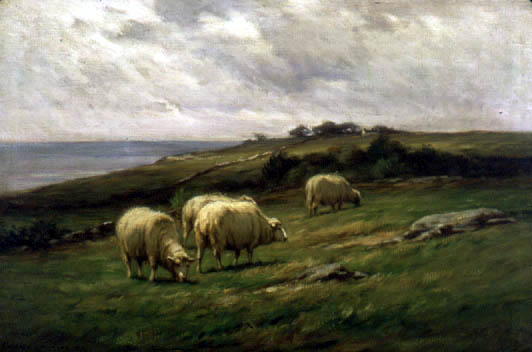Collections
In Situ: The Painted Panel
- Museum Hours: Tuesday through Sunday, 10am to 5pm
Carleton Wiggins (1848 – 1932)
Winter Twilight - Grazing Sheep
As this panel reveals, Carleton Wiggins was inspired by the Barbizon painters of France, who had developed a landscape tradition a half-century earlier that still appealed to many American artists and their patrons. The subject matter is unabashedly rural, the style realistic, and the colors earthy and dark, but the light, especially in the sky, seems caught in flux and casts shadows that transform landscape forms into haunting silhouettes. Paintings like this speak of something age-old and eternal and can feel profound and poetic.
They can also allude to the legendary values and simplicity of an earlier pre-industrial America, which they suggest should not be forgotten. Here, Wiggins counters the drama of a clouded sky at twilight – the special sky of a shoreline place like Old Lyme – with a central arrangement of sheep that are lit as though from within. The boulders at their sides and top ground and appear to protect them in their slow zigzag movement through the terrain.
CARLETON WIGGINS (1848-1932)
WINTER TWILIGHT – GRAZING SHEEP
OIL ON WOOD PANEL
GIFT OF THE ARTIST
Carleton Wiggins had a notable reputation in the American art world of the late 19th century as a Tonalist painter of cattle and sheep. It was subject matter that he specialized in from the time of his student days in France and Holland. While abroad in 1881, his entry in the Paris Salon had been of a shepherd tending his flock. In the early 1900s he was elected a member of the National Academy of Design, where he had once studied with George Inness. He found some of his rural subject matter on Cape Cod, Nantucket, and Long Island, but he painted mostly in Old Lyme, which he first visited in 1903. He returned regularly over the next decade and moved to Lyme year-round in 1915.





